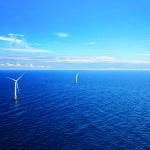The world’s first floating offshore wind farm, located roughly 25 kilometers off the coast of Peterhead, Scotland, powered up October 18, delivering electricity to the Scottish grid.
Hywind Scotland was developed by Norwegian oil company Statoil based on the results of an eight-year demonstration project located off the shore of Karmøy, Norway. The new farm consists of five 6-MW floating wind turbines covering about 4 square kilometers of water at depths between 95 meters and 129 meters. The farm has a total installed capacity of 30 MW. According to Statoil, the wind farm will power approximately 20,000 households.
Each turbine is 253 meters high, 78 meters of which are below the surface. The turbines have a rotor diameter of 154 meters with blades that are 75 meters long. Each turbine weights about 12,000 tonnes and is secured to the sea floor with 15 suction anchors, each of which is connected to the turbine by 2,400-meter-long chains.
“The learnings from Hywind Scotland will pave the way for new global market opportunities for floating offshore wind energy. Through their government’s support to develop the Hywind Scotland project, the UK and Scotland are now at the forefront of the development of this exciting new technology. Statoil looks forward to exploring the next steps for floating offshore wind,” Irene Rummelhoff, executive vice president of New Energy Solutions at Statoil, said in a release.
Statoil partnered with Masdar on the Hywind Scotland project, investing a combined $2 billion. Hywind Scotland’s price tag represents a 60%–70% cost reduction from the Hywind Demo project.
Statoil and Masdar will also install a 1-MWh lithium battery storage system for the project.
Open Seas
The Hywind turbines are suitable for water up to 800 meters deep, opening up areas previously inaccessible for offshore wind. Conventional offshore wind turbines must be embedded in the sea floor, limiting their use to relatively shallow areas near shore. Areas with a narrow continental shelf, such as the west coast of the U.S., are all but inaccessible to conventional offshore wind.
Advances in floating offshore wind, therefore, open up new, potentially lucrative markets to the offshore wind industry. “Key markets for Statoil’s Hywind are in Europe, Japan and West Coast US. Estimates show that the technical potential for floating wind power is 6959 GW for Europe, USA and Japan combined. Of high potential markets, we believe Japan can have [3.5] GW installed by 2030, followed by [2.9] GW in France, 2 GW in the US and finally [1.9] in Ireland/UK,” according to Statoil’s floating offshore wind market outlook.
The outlook notes that not only would floating solar introduce a new product to places like the U.S. and Japan but that there is an existing demand just waiting to be filled. “Here, floating installations could be a game changer, and the key to meeting renewables ambitions. For example, California has set a target of 50% renewable energy, while in Japan, the shift away from nuclear power will drive the need for new and reliable energy supplies,” the outlook says.
Looking Forward
Statoil is already working to develop its next large-scale project, a full-scale floating wind farm that will likely be located in Ireland, France, off the U.S. west coast, Japan, or possibly Norway.
Statoil predicts that floating offshore wind, though it is in its infancy, will see the same significant cost reductions that onshore and conventional offshore wind have seen in recent years.
“Statoil has an ambition to reduce the costs of energy from the Hywind floating wind farm to € 40-60 €/MWh by 2030. Knowing that up to 80% of the offshore wind resources are in deep waters (+60 meters) where traditional bottom fixed installations are not suitable, floating offshore wind is expected to play a significant role in the growth of offshore wind going forward,” Rummelhoff said.
—Abby L. Harvey is a POWER reporter.









